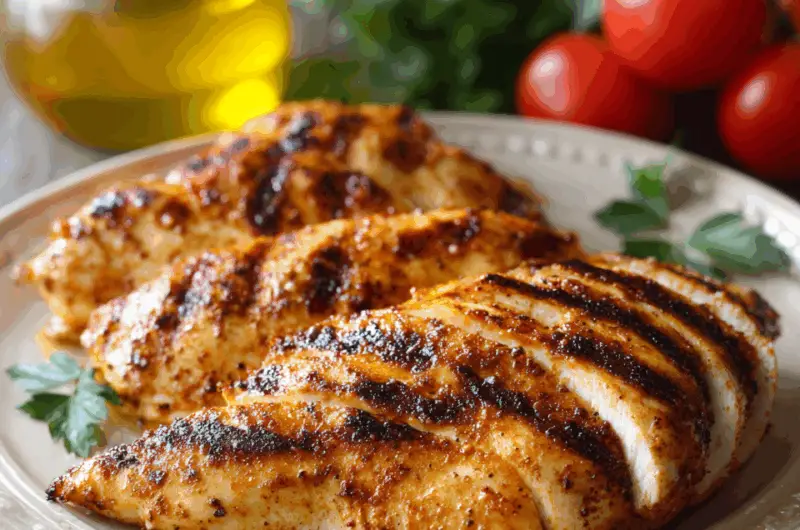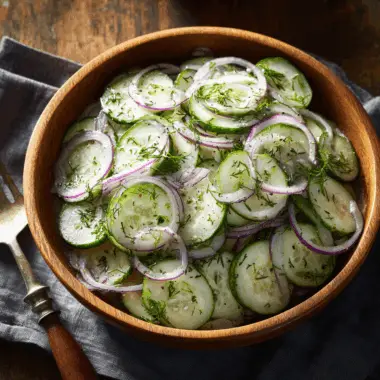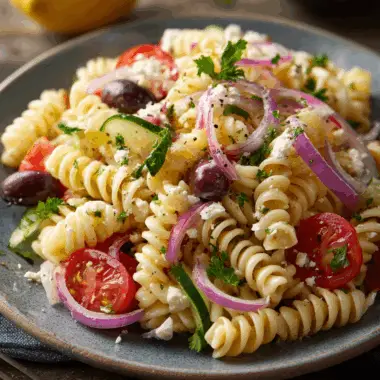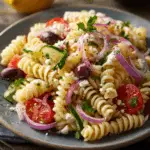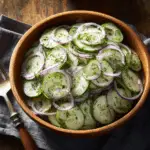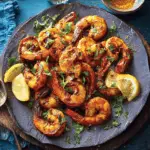The secret to truly juicy grilled chicken breasts? A simple brine and smart grilling technique. By soaking your chicken in a saltwater solution for just 30 minutes, you lock in moisture and amplify natural flavor—no need for heavy sauces or excessive seasoning.
Once brined, a quick rub with olive oil and paprika adds color and richness before these tender breasts hit the grill. Start hot to sear and seal in juices, then finish low and slow to avoid overcooking. The result: a perfect, protein-packed main dish that’s both healthy and crave-worthy—ideal for salads, sandwiches, or your summer dinner table.
Full Recipe:
-
4 cups cool water
-
1/4 cup kosher salt (Diamond Crystal preferred)
-
1.5 to 2 lbs boneless skinless chicken breasts
-
3 tablespoons extra virgin olive oil (plus extra for grill grates)
-
1.5 teaspoons paprika
Directions:
-
Brine the Chicken: In a large mixing bowl, dissolve the salt in water. Add the chicken breasts and refrigerate for 30 minutes.
-
Prepare the Grill: Set your grill for two-zone cooking—high direct heat on one side and lower indirect heat on the other. If using a grill pan, preheat it over medium-high heat.
-
Season the Chicken: Remove chicken from the brine and pat dry thoroughly with paper towels. Rub all sides with olive oil and sprinkle evenly with paprika.
-
Grill Over High Heat: Brush grill grates with olive oil. Place chicken on the hot side of the grill. Grill uncovered for 3-5 minutes until nice sear marks form.
-
Finish Over Low Heat: Flip and move chicken to the cooler side of the grill. Cover and cook until internal temperature reaches 155°F (about 5–8 minutes).
-
Rest Before Serving: Remove from grill, cover loosely with foil, and rest for 5–10 minutes to allow juices to redistribute and carryover cooking to complete.
Prep Time: 35 minutes (includes brine) | Cooking Time: 10-15 minutes | Total Time: 50 minutes
Kcal: 373 kcal per serving | Servings: 4
Why Grilled Boneless Skinless Chicken Breasts Can Be Tricky
Grilling chicken breasts—especially boneless and skinless—might seem simple, but it’s often where many home cooks go wrong. This cut of chicken is lean, meaning it lacks the fat that usually helps meat stay moist during high-heat cooking. Without bones or skin to provide insulation, chicken breasts tend to dry out quickly on the grill, leading to a rubbery texture and bland taste. However, with the right technique, this affordable and healthy cut can be transformed into a delicious, juicy masterpiece.
The Science Behind Brining
One of the key factors that elevate this grilled chicken breast recipe is brining. Brining involves soaking the chicken in a solution of water and salt, allowing the meat to absorb moisture and seasoning before it even hits the grill. This process not only enhances the chicken’s ability to retain moisture but also subtly infuses it with flavor.
During brining, osmosis and diffusion come into play. Salt breaks down muscle proteins, which loosens the meat’s structure and allows it to hold onto more water. The result? A juicier bite after cooking. The beauty of this recipe lies in its simplicity—you only need 30 minutes in the brine for noticeably better results. This is a far cry from overnight brining processes, making it perfect for weeknight meals or impromptu gatherings.
Why Paprika and Olive Oil Make a Difference
Once brined, the chicken gets coated in a combination of olive oil and paprika. These two ingredients serve more than just a cosmetic purpose. Olive oil helps prevent the chicken from sticking to the grill while promoting even browning. Its high smoke point makes it suitable for grilling, and its subtle flavor complements the natural taste of the chicken.
Paprika, on the other hand, adds both color and a touch of earthy sweetness. While the spice level is low, the visual appeal is high—paprika gives the chicken a golden, slightly smoky finish that’s incredibly appetizing. This rub keeps things uncomplicated, letting the brined chicken shine while giving it that classic grilled look.
Mastering the Two-Zone Grilling Method
Perhaps one of the most crucial steps in this method is the two-zone grilling technique. Instead of cooking the chicken over direct high heat for the entire duration, the chicken is first seared over the hot side of the grill to achieve those beautiful grill marks and caramelized flavors. Then, it’s moved to a cooler part of the grill where it can finish cooking gently.
This transition allows for controlled heat exposure, ensuring the outside doesn’t burn before the inside reaches a safe temperature. Overcooking is the enemy of juicy chicken, and this method mitigates that risk significantly. For gas grills, this means only igniting one side and placing the chicken on the unlit side after searing. For charcoal, it involves pushing coals to one side to create distinct heat zones.
Why 155°F Is the Magic Number
Most food safety guidelines recommend cooking chicken to an internal temperature of 165°F. However, this recipe suggests pulling the chicken off the grill when it hits 155°F, then letting it rest. Why? Because of carryover cooking.
When meat is removed from the heat source, it continues to cook as it rests. During this time, internal temperature rises—usually by about 5 to 10 degrees. By removing the chicken at 155°F, it naturally reaches the ideal 165°F while resting under foil. This technique ensures you never overcook the meat and allows the juices to redistribute evenly, resulting in a moist and flavorful outcome.
The Importance of Resting Meat
Allowing the chicken to rest after grilling isn’t just a suggestion—it’s a culinary rule. If you cut into the chicken immediately after removing it from the grill, the juices will spill out onto your cutting board rather than stay in the meat. Resting for 5 to 10 minutes helps lock those juices inside the chicken, maintaining tenderness and enhancing the eating experience.
During this rest period, the muscle fibers relax, and moisture is reabsorbed into the fibers. It’s a simple step with a major payoff and should never be skipped, especially for lean meats like chicken breasts.
Health Benefits of This Dish
This grilled chicken breast recipe doesn’t just taste amazing—it’s also nutritionally smart. At around 373 calories and 53 grams of protein per serving, it’s an ideal option for those following high-protein, low-carb, or balanced diets. Since the recipe doesn’t rely on sugar-laden sauces or heavy marinades, it remains low in carbohydrates and free from unnecessary additives.
The use of olive oil contributes healthy fats, particularly monounsaturated fats, which are heart-friendly. Meanwhile, paprika contains antioxidants like capsaicin and beta-carotene, which have anti-inflammatory properties. This dish is proof that healthy food doesn’t have to be bland or boring.
Versatility in Meal Planning
Grilled boneless skinless chicken breasts are an incredibly versatile meal prep component. You can enjoy them freshly grilled or prepare a batch ahead of time for use throughout the week. Slice them over salads, stuff them into wraps, serve them alongside grilled vegetables, or toss them with pasta for a more substantial meal.
They also pair well with almost any cuisine—from Mediterranean (think lemon, olives, and tzatziki) to Latin American (add lime, cilantro, and avocado). Once you’ve mastered this basic preparation, the possibilities are endless.
Ideal for Outdoor Gatherings and Family Meals
This grilled chicken recipe is also a crowd-pleaser at barbecues and family dinners. Since the flavor profile is neutral and appealing to all ages, it’s perfect for feeding a group. You can double or triple the batch without adding much complexity to the cooking process.
Because it’s gluten-free and naturally dairy-free, it fits into a variety of dietary preferences, making it a smart choice for gatherings where guests may have different food sensitivities or restrictions.
Common Mistakes to Avoid
While the recipe is relatively simple, there are a few common pitfalls to watch out for:
-
Skipping the brine: Even 15 minutes can make a difference. Don’t skip this crucial step.
-
Using high heat throughout: This leads to a burnt exterior and dry interior.
-
Not using a meat thermometer: Guesswork often leads to overcooked chicken. Invest in a thermometer for consistent results.
-
Skipping the rest period: Always give your chicken a few minutes to rest before slicing.
-
Using cold chicken straight from the fridge: Letting it come to room temperature for 15 minutes before grilling helps it cook more evenly.
Conclusion
Grilled boneless skinless chicken breasts don’t have to be dry, flavorless, or boring. By incorporating a simple brine, a paprika-infused olive oil rub, and smart grilling techniques like two-zone cooking and proper resting, you can achieve restaurant-quality results right in your backyard.
This method respects the nature of the meat—lean, delicate, and easy to mishandle—and uses science and culinary best practices to bring out its best qualities. Whether you’re meal prepping for the week, serving guests at a cookout, or just trying to perfect your grilling skills, this recipe delivers every time.
So next time you’re eyeing those plain chicken breasts at the store, know that you’re just a few simple steps away from transforming them into a mouthwatering meal that’s as nutritious as it is delicious.

